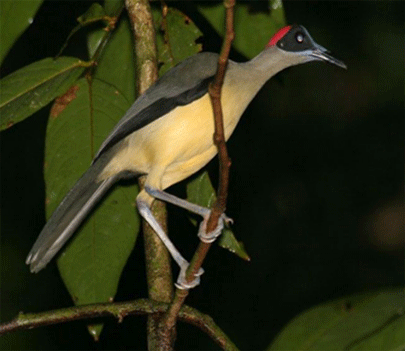Conservation of the threatened Red-headed Picathartes
By Guilain Tsetagho
 |
|
Grey-necked picathartes. Photo credit: Deli Victor. |
The Grey-necked or red-headed picathartes, also called Cameroon rockfowl (Picathartes oreas), is among the elusive and enigmatic birds of the African rainforests. It is a very attractive and large bird with carmine, black and lilac, dark bluish-grey upper parts with silky grey throat and breast and yellow belly. Also, it is one of only two members of the Picathartidae, a passerine family endemic to the equatorial tropical forest of Central and Western Africa (Atul et al., 2014). The Grey-necked Catharses is restricted to the tropical Lower Guinea forest of Nigeria, Equatorial Guinea, Gabon and Cameroon, with a highly fragmented and declining global population estimated at 2,500–10,000 individuals.
The rockfowl breeds particularly in small colonies of variable sizes of 1–15 nests (Thompson 1997; Atuo et al. 2014). The nest is in cup-shaped mud nests usually attached to rock overhangs, rock crevices or caves within closed-canopy forests. An array of threats including habitat loss (Awa et al., 2009), predation and hunting (Atuo et al., 2014), has led to low availability of nest sites and low fertility of eggs, along with infanticide and stress due to disturbance, leading to low breeding success (Bian et al., 2006) leading to a serious decline.
The grey-necked is classified vulnerable under the IUCN Red List and listed on Appendix I of CITES. In Cameroon, the bird is a Class A protected species, meaning that any form of exploitation is prohibited and it’s under the watch and ward of the Minister in charge of wildlife.
The population ecology of grey-necked picathartes is not well delineated but for studies done by Awa et al. (2009), in southern Cameroon’s Mbam-Mimkom forest and by Atuo et al. (2014) in Southern Nigeria. A Species Action Plan was developed by Bian et al. (2006). Baseline studies about grey-necked population trends, looming threats and conservation awareness are ongoing in Cameroon. Also, as recommended by Bian et al. (2006), ex-hunters have been recruited as field guides and young students trained for long term monitoring of this charismatic species.
References
Atuo, F. A., Ivande, S. T., Wala, Z. and O’Connell, T. J. (2014). Effects of hunting camps on breeding grey-necked picathartes Picathartes oreas in south-east Nigeria. Oryx 48: 460 – 464.
Awa II, T., Dzikouk, G. and Norris, K. (2009). Breeding distribution and population decline of globally threatened Grey-necked Picathartes Picathartes oreas in Mbam Minkom Mountain Forest, southern Cameroon. Bird Conserv. Inter. 19: 254 – 264.
Bian, R.M., Awa, T., Ndang’ang’a, P.K., Fotso, R., Hoffmann, D., and Sande, E. (2006) (eds). International Species Action Plan for the Grey-necked Picathartes Picathartes oreas. Nairobi, Kenya and Sandy, Bedfordshire, UK: BirdLife International and Royal Society for the Protection of Birds.
Thompson (1997). The breeding biology and ecology of the White-necked Picathartes Picathartes gymnocephalus Temminck 1825 in Sierra Leone. PhD thesis, Open University, UK.